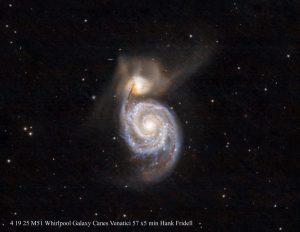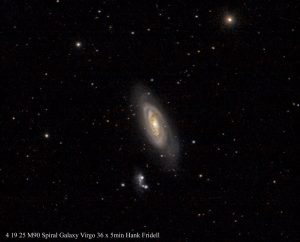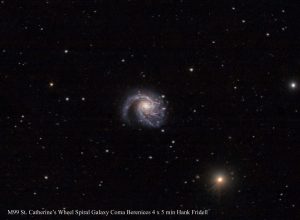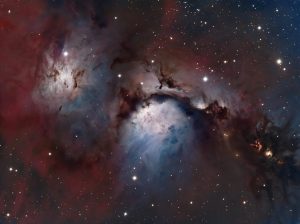Welcome to Hank’s April 2025 Astrophotography Blog. Spring is showing up, and with it the light snows of Winter have been replaced by rain, and our days are longer. In short, most nights seem to be filled with the Moon or clouds, and our dark sky nights are shorter. It’s hard to predict when there will be good viewing, so I’ve been keeping my eyes on a couple of internet resources to help me out.
For up-to-date cloud cover images I go to: https://www.cleardarksky.com/maps/satellite/HddnVlyObSD.html
The bulls-eye circle shows the location of the Black Hills Astronomical Society Observatory. This really lets me see the clouds that are headed my way.
On my iPhone I use two apps, both available at the Apple Store. 1. Clear Outside shows the percentage of clouds that are low, middle and high. Also, it shows when the Sun and Moon come up and go down, the brightness of the Moon, chance of rain, wind speed, temperature, the Borlel of my sky, etc. (I’ve talked about Bortel before, but briefly it is the amount of light pollution at my location). 2. The Astrospheric app shows much the same data as Clear Outside, but it has a map of my location and how much cloud cover there is. Generally, the two apps agree on the general condition of the skies at night, but the difference is in the details and I have not been able to see if one is consistently more accurate than the other.
On the 18th I was able to capture a few more hours of M51, the Whirlpool Galaxy. I was able to combine my images of M51 from both February and April to add up to nearly 5 hours. I also photographed M104, the Sombrero Galaxy, an edge-on galaxy with a very cool shape.
On the 19th I was able to get three hours of light from M90, a Spiral Galaxy in the Virgo Cluster of galaxies. The extra hours of capture really show more details of an object whose light took about 60 million years to reach my telescope! Even though M99 is in a different constellation than M90, it is still considered part of the Virgo Cluster, as it is visually in the same neighborhood for us Earthlings, but M99 is actually about 15 million light years closer to us.
Finally, the Black Hills Astronomical Society’s Winter Capture Project of M78, (I posted my photo in the January Blog) has finally been processed. Several members contributed captured images to the project and many of them (with better processing skills than me) did the work of combining all of our images. Here’s Chris’s final product.
Until next month, Clear Skies! -Hank








